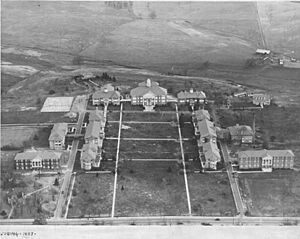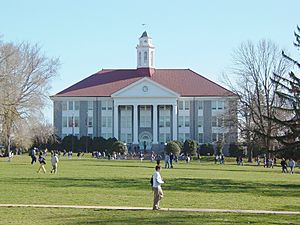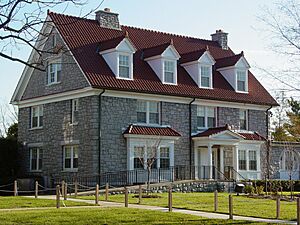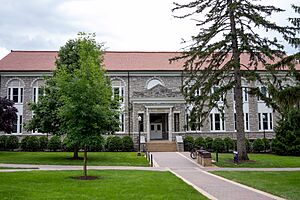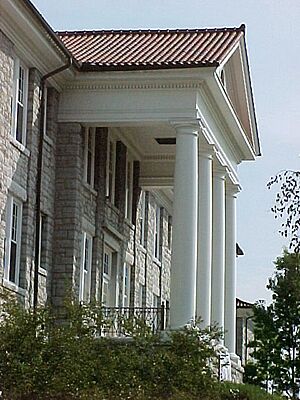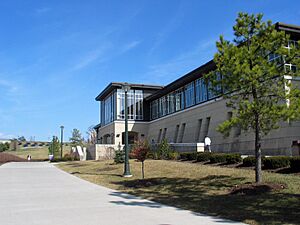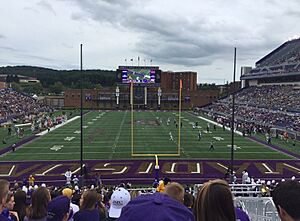James Madison University facts for kids
 |
|
|
Former names
|
State Normal and Industrial School (1908–1914) State Normal School for Women at Harrisonburg (1914–1924) State Teachers College at Harrisonburg (1924–1938) Madison College (1938–1977) |
|---|---|
| Motto | "Knowledge is Liberty" |
| Type | Public research university |
| Established | February 29, 1908 |
| Accreditation | SACS |
|
Academic affiliations
|
|
| Endowment | $154.7 million (2021) |
| Budget | $825 million (2025) |
| President | James C. Schmidt |
|
Academic staff
|
1,463 (2022) |
| Students | 22,224 (2022) |
| Undergraduates | 20,346 (2022) |
| Postgraduates | 1,878 (2022) |
| Location |
,
,
United States
|
| Campus | Small City, 721 acres (2.92 km2) |
| Other campuses | |
| Newspaper | The Breeze |
| Colors | Purple Gold |
| Nickname | Dukes |
|
Sporting affiliations
|
|
| Mascot | Duke Dog |
James Madison University (often called JMU) is a public university in Harrisonburg, Virginia, USA. It was started in 1908. In 1938, it was named after James Madison, who was the fourth president of the United States. JMU began as a school for women to become teachers. Today, it is a large university. It is located in the beautiful Shenandoah Valley.
Contents
History of James Madison University

How JMU Started
James Madison University opened in 1908. The state of Virginia created it as a college for women. Its first name was The State Normal and Industrial School for Women at Harrisonburg. In 1914, its name changed to the State Normal School for Women at Harrisonburg. By 1916, the school could give out bachelor's degrees. Six buildings were built during these early years.
In 1924, the university became the State Teachers College at Harrisonburg. Then, in 1938, it was named Madison College. This was to honor James Madison, the fourth U.S. President. His home, Montpelier, is nearby. In 1977, the name changed again to James Madison University.
The first president of the university was Julian Ashby Burruss. When it opened in 1909, there were 209 students and 15 teachers. The first 20 students graduated in 1911.
Growth and New Leaders
In 1919, President Burruss left. Samuel Page Duke became the second president. During his time (1919-1949), nine new buildings were added.
In 1946, men were allowed to enroll as full-time students for the first time. G. Tyler Miller became the third president in 1949. From 1949 to 1970, the campus grew by 240 acres. Nineteen new buildings were constructed. The university also started offering master's degrees in 1954.
By 1966, the university became fully coeducational, meaning both men and women could attend. Ronald E. Carrier was the fourth president from 1971 to 1998. The Carrier Library is named after him.
JMU in the 21st Century
Under Linwood H. Rose, the fifth president, JMU continued to grow. New buildings were added on both sides of the campus. In 2005, JMU bought the old Rockingham Memorial Hospital campus. The university now uses this land.
In March 2025, it was announced that James C. Schmidt would become the seventh president. He started his role in July 2025.
JMU Campus

JMU's campus started with just two buildings. Today, it has 148 main buildings on 721 acres. It is one of the most photographed places in Virginia on social media.
The older part of campus is called the Bluestone area. Many buildings here are made from a local stone called "bluestone." This stone comes from the nearby Shenandoah Valley.
In 2002, JMU began building a performing arts center. This large facility opened in 2010. It has two buildings for theater, dance, and music performances.
Renaming Campus Buildings
In 2020, JMU decided to rename three old buildings. These buildings were originally named after Confederate soldiers. Their temporary names were Valley Hall, Mountain Hall, and Justice Studies Hall.
In 2021, these halls received new, permanent names:
- Mountain Hall (formerly Maury Hall) became Gabbin Hall. It was named after Drs. Joanne V. and Alexander Gabbin. They were professors at JMU for over 35 years.
- Valley Hall (formerly Ashby Hall) became Harper Allen-Lee Hall. This honored Doris Harper Allen and Robert Walker Lee. They were important staff members at JMU.
- Justice Studies Hall (formerly Jackson Hall) became Darcus Johnson Hall. This honored Sheary Darcus Johnson. She was the first Black student to graduate from JMU.
In late 2021, the ISAT/CS building was renamed King Hall. This was to honor Charles W. King. He was a Senior Vice President at JMU for a long time.
How JMU is Organized
Academic Colleges
JMU has seven main colleges. These colleges offer many different subjects to study.
- College of Arts and Letters
- College of Business
- College of Education
- College of Health and Behavioral Studies
- College of Integrated Science and Engineering
- College of Science and Mathematics
- College of Visual and Performing Arts
- The Graduate School
The College of Visual and Performing Arts includes schools for art, design, music, theater, and dance.
University Leaders
Like other public universities in Virginia, JMU is led by a Board of Visitors. The Governor of Virginia chooses these members. The head of the Faculty Senate and a student representative also serve on the board.
JMU Presidents
- Julian Ashby Burruss (1908–1919)
- Samuel Page Duke (1919–1949)
- G. Tyler Miller (1949–1971)
- Ronald E. Carrier (1971–1998)
- Linwood H. Rose (1999–2012)
- Jonathan R. Alger (2012–2024)
- Charlie King (interim; 2024–2025)
- James C. Schmidt (2025–present)
Academics at JMU
JMU offers many different degree programs. Students can earn bachelor's, master's, and doctoral degrees. There are 139 different programs to choose from. In the 2012–13 school year, almost 20,000 students were enrolled. Most of these were undergraduate students.
In 2009, JMU was given a chapter by the Phi Beta Kappa honor society. This is a special award for excellent academic schools.
University Rankings
| USNWR National University | 124 |
|---|---|
| Washington Monthly National University | 75 |
| Forbes | 136 |
U.S. News & World Report ranked JMU No. 124 among national universities in 2024. Washington Monthly ranked JMU eighth among master's universities in 2018. This ranking looks at how well schools help students, their research, and community service.
Student Life
| Race and ethnicity | Total | ||
|---|---|---|---|
| White | 75% |
|
|
| Hispanic | 7% |
|
|
| Other | 7% |
|
|
| Asian | 5% |
|
|
| Black | 5% |
|
|
| Foreign national | 1% |
|
|
| Economic diversity | |||
| Low-income | 14% |
|
|
| Affluent | 86% |
|
|
JMU is known for its happy students and good food. In 2010, the food at JMU was ranked third best in the United States. In 2011, Newsweek and The Daily Beast said JMU students were among the happiest in the nation.
The Breeze Newspaper
The Breeze is a newspaper written by students. It has served JMU since 1922. The Breeze has won many awards for its reporting.
Clubs and Organizations
James Madison University has over 400 clubs and groups for students. These include groups for different interests and cultures.
The Student Government Association (SGA) helps run many university events. They also manage money for student organizations. SafeRides is a student-led group that gives free rides to students at night. It started in 2003 and has given over 100,000 rides by 2022.
JMU Student Ambassadors give tours to students who want to come to JMU. They are volunteers who help new students learn about the campus.
Greek Life
JMU has many fraternities and sororities. These are social groups that students can join. Over 4,800 students are part of Greek life. This means more than 20% of undergraduate students participate. Greek life officially started at JMU in 1939.
Music at JMU
JMU has the largest college marching band in the country. It has 540 members as of Fall 2022. The band is called the "Marching Royal Dukes." They have performed at presidential inaugurations and the Macy's Thanksgiving Day Parade. They have also performed in Europe.
The JMU Brass Band is one of the few college brass bands in the U.S. They have won national championships.
JMU also has ten a cappella groups. These groups sing without instruments. Many of them have been featured on national music albums. Some groups have even made popular music videos. Note-oriety, one of the groups, performed at the White House in 2019.
Club Sports
JMU has many club sports teams. The men's and women's club soccer teams are very successful. The men's ultimate frisbee team, the Flying Hellfish, hosts a yearly tournament.
JMU Athletics
JMU's sports teams are called the Dukes. Their mascot is an English bulldog named Duke Dog. The nickname "Dukes" honors Samuel Page Duke, a former university president. The school colors are royal purple and gold. JMU competes in NCAA Division I sports.
JMU has over 546 athletes on various teams. These include football, basketball, soccer, tennis, and more. JMU has won five national championships. These include two in football, and one each in field hockey, women's lacrosse, and archery.
JMU has invested a lot in new sports facilities. A new baseball and softball complex opened in 2010. Bridgeforth Stadium, where the football team plays, was expanded in 2011. It can now seat about 25,000 fans.
Basketball
In 2013, the men's basketball team won their conference championship. They then won their first NCAA tournament game in 30 years.
After moving to the Sun Belt Conference in 2022, the men's team won their first Sun Belt title in 2024. They then won their first game in the NCAA Tournament against Wisconsin. They made it to the second round before losing to Duke.
The women's basketball team has won 5 national championships and 15 conference championships. They won a Sun Belt conference tournament in 2023. They also made it to the NCAA tournament that year.
Football
JMU football won the NCAA Division I-AA national title in 2004 and 2016. The 2004 team was the only one to win the title after playing four straight away playoff games.
In 2022, JMU football moved to the Football Bowl Subdivision (FBS). In their first three years in the FBS, they won their first bowl game at the Boca Raton Bowl in Florida.
Famous People Who Went to JMU
Many notable people have graduated from James Madison University.
Sports Stars
- Daniel Brown, football player
- Gary Clark, football player
- Charles Haley, football player
- C. J. Sapong, soccer player
Business Leaders
- Jennifer Morgan, Co-Chief Executive Officer of SAP SE
- Christina Tosi, owner of Momofuku Milk Bar; MasterChef judge
- Kathy J. Warden, CEO of Northrop Grumman
Entertainment and Media
- Sarah Baker, actress
- Steve James, documentary producer and director
- Reshma Shetty, actress
- Jim Acosta, Senior White House Correspondent for CNN
- Lawrence Jackson, photojournalist
Musicians
- Everything, '90s rock band
- Joe Hottinger, musician
- Leroi Moore, musician
- Old Dominion, country musicians and songwriters
- Phil Vassar, country music singer
Government and Politics
- Kirk Cox, former Speaker of the Virginia House of Delegates
- Jason Miyares, Attorney General of Virginia
- Levar Stoney, Mayor of Richmond, Virginia
See also
 In Spanish: Universidad James Madison para niños
In Spanish: Universidad James Madison para niños


